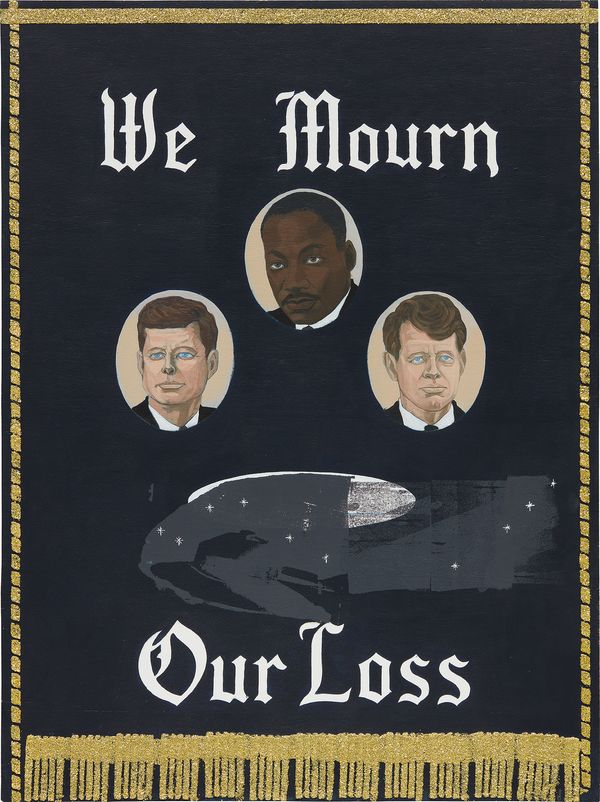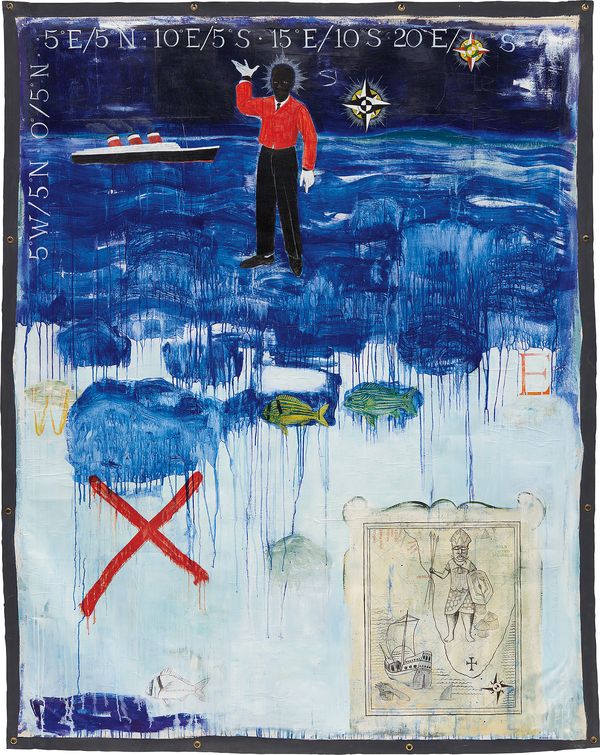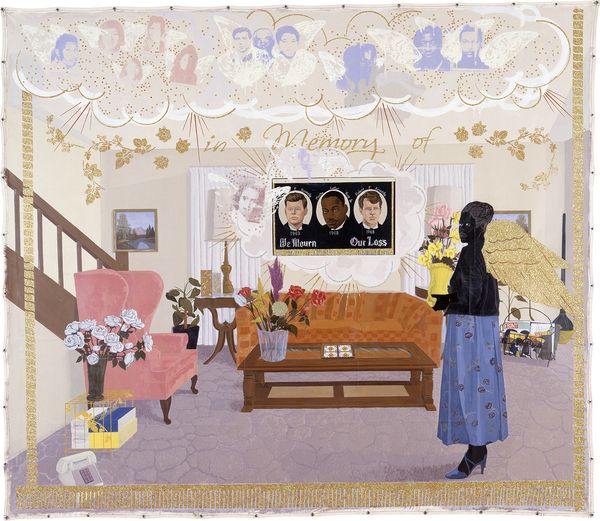Kerry James Marshall, We Mourn Our Loss #1, 1997.
When Kerry James Marshall's Past Times from 1997 soared to sell for $21.1 million in May 2018, the Chicago-based artist entered the annals of art history as the most expensive living African-American artist at auction. Following in the heels of his highly acclaimed solo exhibition that traveled to The Metropolitan Museum of Art, New York, the Museum of Contemporary Art, Chicago and the Museum of Contemporary Art, Los Angeles in 2017, this marked a jubilant moment for an artist who for the past 35 years has relentlessly sought to reassert the place of the black figure in the canon of painting.
It all began in 1980 when Marshall—then a 25-year-old Los-Angeles based artist fresh out of art school—painted his seminal Portrait of the Artist as a Shadow of His Former Self. Inspired by Marshall's reading Ralph Ellison's 1952 novel Invisible Man, this small painting, which is now held in the collection of the Museum of Contemporary Art, Los Angeles, set the foundation for many of the themes that have informed Marshall's practice ever since, including the dialectic of absence and presence, the systematic interrogation of art historical genres and a free-ranging mash-up of artistic styles and tropes.
The condition of blackness in the paintings would be more absolute, not provisional.
– Kerry James Marshall
Building a steady following in Los Angeles throughout the early 1980s, Marshall made his New York art world debut in 1985 upon receiving the Artist-in-Residence Fellowship at The Studio Museum in Harlem. It was the very postcard reproduction created for Marshall's 1986 exhibition at the museum that caught Jack Shainman's attention later in the early 1990s on a visit to another artist’s studio.
Kerry James Marshall Terra Incognita, 1991
Immediately drawn to his work, Shainman tracked Marshall down and flew to Chicago, where the artist had since moved. Terra Incognita, 1991, was among the very first works by Marshall that Shainman saw in person when visiting the exhibition Terra Incognita: Kerry James Marshall and Santiago Vaca at the Chicago Cultural Center in 1992. This encounter marked the beginning of a critical working relationship, which in the next year would result not only in Marshall's first solo exhibition at the gallery but also lead to the Los Angeles County Museum's acquisition of De Style, 1993, the first work by Marshall to enter a major museum collection.
A truly foundational painting, Terra Incognita attests to the pivotal juncture in Marshall's career in the early 1990s when he began to embrace narrative dimensions and investigate large-format painting. Terra Incognita is one of the first major large-format history paintings in Marshall's oeuvre and set the foundation for his Lost Boys, 1993, and Garden Project, 1994-1995, series. These early works garnered Marshall widespread acclaim and paved his way for inclusion in the Whitney Biennale and the Documenta X in Kassel, both in 1997, the same year Marshall was awarded the prestigious MacArthur Foundation grant.
Around the same time, Marshall was creating We Mourn Our Loss #1, 1997, for the exhibition Kerry James Marshall: Mementos that would open at the Renaissance Society, Chicago, and traveled to the Brooklyn Museum of Art, San Francisco Museum of Modern Art, The Institute of Contemporary Art, Boston, the Santa Monica Museum and the Boise Art Museum between 1998 and 2000. Representing the most comprehensive survey of Marshall's work, the career-defining exhibition firmly announced Marshall's self-identification as a history painter.
Kerry James Marshall, Souvenir II, 1997. Addison Gallery of American Art, Andover, Image Art Resource, NY, Artwork © Kerry James Marshall
Marshall conceived Mementos as a requiem to the 1960s, a decade synonymous with the Civil Rights Movement. Rather than construct overly historical or political accounts, Marshall characteristically delved into the private and domestic dimensions of this legacy: excised from the domestic scenes of Souvenir I, Museum of Contemporary Art, Chicago, and Souvenir II, Addison Gallery of American Art, We Mourn Our Loss # 1 presents a trompe-l'oeil painting of the very gold-tasseled banners honoring heroes of the civil rights movement such as Reverend Dr. Martin Luther King, President John F. Kennedy, and Senator Robert Kennedy.
You can’t be born in Birmingham, Alabama, in 1955 and grow up in South Central [Los Angeles] near the Black Panthers headquarters and not feel like you’ve got some kind of social responsibility. – Kerry James Marshall
Terra Incognita and We Mourn Our Loss #1 are truly foundational works that together offer a snapshot of the defining decade of the 1990s that set in motion Marshall’s ascent to one of the foremost artists of his generation. View both works in the Evening Sale preview from November 2 through November 15 at our Park Avenue gallery.


